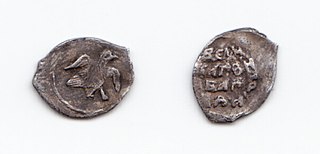Top Qs
Timeline
Chat
Perspective
Polushka
Historical Russian coin equal to 1/4 kopeck From Wikipedia, the free encyclopedia
Remove ads
A polushka (Russian: полушка, "half [of a denga]"), also historically known as a poludenga (Russian: полуденга), was a Russian coin with a value equal to 1⁄2 denga. Following the 1535 monetary reform of Elena Glinskaya, it had a value equal to 1⁄4 kopeck (100 kopecks = 1 ruble).




Remove ads
History
Summarize
Perspective
The coin was minted from the 1390s in the Grand Principality of Moscow, specifically in Moscow, Serpukhov, Zvenigorod, Mozhaysk, and Dmitrov.[1] It was also minted in the appanage principalities of Nizhny Novgorod and Rostov.[1] From the late 15th century, it was also minted in Novgorod and Tver.[1] At the time, it had a value of 1⁄2 moskovka (Moscow denga), with a weight of approximately 0.4g, with 400 polushkas being equal to a ruble.[1]
The coins had images of horsemen, warriors, animals, and birds.[1] The inscriptions on the coins bore the name of princes who issued the coin.[1] There are also rare coins from the 14th and early 15th centuries that contain the inscription poldengi moskovskiye (Russian: полъденги московские, lit. 'Muscovite half-dengas').[1] The term poludenga is mentioned in written sources from the late 15th century.[1]
In the centralized Russian state, it was the smallest silver coin.[1] In the 16th and 17th centuries, the coins were issued with "P." simply shown as the denomination.[1] Following the 1535 monetary reform of Elena Glinskaya, it was made equal to 1⁄4 kopeck with an approximate weight of 0.17g.[1] The last silver coins were minted in the early 1680s, with an approximate weight of 0.09g.[1]
From around 1700 to 1810 and from 1850 to 1867, copper coins with the inscription "P." were issued.[1] From 1839 to 1846 and 1867 to 1916, such coins were issued with the denomination shown simply as 1⁄4 kopeck.[1]
Remove ads
Minting dates
- Peter the Great (1700–1716, 1718–1722)
- Anna of Russia (1730–1731, 1734–1740)
- Ivan VI of Russia (1741)
- Elizabeth Petrovna (1743–1751, 1754, 1757–1759)
- Catherine II of Russia (1766–1773, 1775, 1783–1796)
- Paul I of Russia (1797–1800)
- Alexander I of Russia (1803–1805, 1807–1808,1810)
- Nicholas I of Russia (1839–1846, 1849–1855)
- Alexander II of Russia (1855–1881)
- Alexander III of Russia (1881–1894)
- Nicholas II of Russia (1894–1900, 1909–1910, 1915–1916)
Remove ads
See also
References
Sources
Wikiwand - on
Seamless Wikipedia browsing. On steroids.
Remove ads
